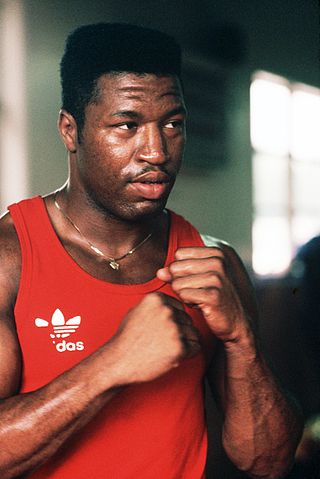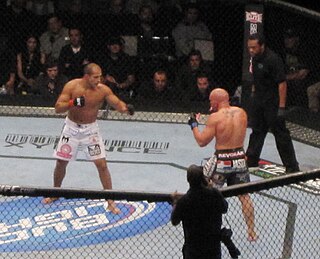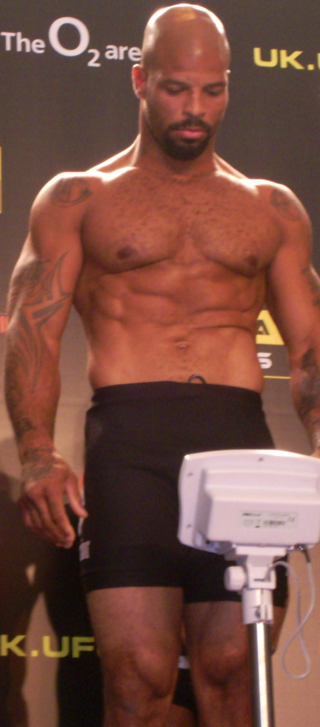
Boxing is a combat sport and a martial art in which two people, usually wearing protective gloves and other protective equipment such as hand wraps and mouthguards, throw punches at each other for a predetermined amount of time in a boxing ring.

Raymond Anthony Mercer is an American former professional boxer, kickboxer, and mixed martial artist who competed from 1989 to 2009. Best known for his boxing career, Mercer won a heavyweight gold medal at the 1988 Summer Olympics as an amateur, and later held the WBO heavyweight title in 1991 as a professional, making one successful title defense against Tommy Morrison before vacating his championship. Though he fought and lost a controversial unanimous decision fight to former champion Evander Holyfield, he scored a notable unanimous decision win over two-time heavyweight champion Tim Witherspoon in 1996. Throughout his entire fighting career in the 1990s, Mercer never lost a fight to stoppage a testament to his iron jaw and dangerous resilience as a boxer.

Mixed martial arts (MMA) is a full-contact combat sport based on striking, grappling and ground fighting, incorporating techniques from various combat sports from around the world. The first documented use of the term mixed martial arts was in a review of UFC 1 by television critic Howard Rosenberg in 1993.

Ken Shamrock is an American retired professional wrestler and mixed martial artist. He is best known for his time in Ultimate Fighting Championship (UFC) and other combat sports. An inaugural inductee into the UFC Hall of Fame, Shamrock is widely regarded as an icon and pioneer of the sport. He has headlined over 15 main events and co-main events in the UFC and Pride FC and set numerous MMA pay-per-view records. In the early part of his UFC career, Shamrock was named "The World's Most Dangerous Man" by ABC News in a special called "The World's Most Dangerous Things". The moniker has stuck as his nickname.

David Lee "Tank" Abbott is an American retired mixed martial arts fighter, professional wrestler, and author. He currently hosts his own podcast series titled "The Proving Ground with Tank Abbott." Abbott is perhaps best known for being an icon in the early stages of mixed martial arts and the UFC, but has also competed in the PRIDE Fighting Championships, Strikeforce, EliteXC, and Cage Rage, challenging for the UFC heavyweight Championship once in 1997 His fighting style, which he developed brawling in the bars and streets of Huntington Beach, California, was described by his future manager Dave Thomas as "Pit Fighting". He also authored a novel titled Bar Brawler.

James Thompson is an English professional mixed martial artist who competes in the heavyweight division. A seasoned professional competitor since 2003, Thompson has also formerly competed for PRIDE FC, Bellator MMA, Cage Rage, EliteXC, Sengoku, DREAM, KSW, Rizin, and the SFL. He last fought for Bellator in 2017.
Arthur Jimmerson is an American retired boxer & mixed martial artist who competed at super middleweight, light heavyweight, and cruiserweight. As an amateur, Jimmerson was the 1983 National Golden Gloves Middleweight champion. He finished his boxing career in 2002, with a record of 33–18.

American Top Team (ATT) is one of the primary teams in mixed martial arts. The gym was founded by Dan Lambert, who brought in former members of Brazilian Top Team Marcus "Conan" Silveira, Marcelo Silveira and Ricardo Liborio, but there is no formal affiliation between the two teams. ATT's main academy is in Coconut Creek, Florida, and there are affiliated academies throughout the United States. ATT features professional fighters who have competed in many major promotions, such as the Ultimate Fighting Championship (UFC), PRIDE Fighting Championships, DREAM, K-1, Strikeforce, Bellator, Professional Fighters League (PFL) and ONE Championship.

Houston Alexander is an American former professional mixed martial artist who last competed in 2017. A professional competitor since 2001, he has fought for the Ultimate Fighting Championship (UFC), Bellator MMA, Shark Fights, the Resurrection Fighting Alliance (RFA), and Konfrontacja Sztuk Walki (KSW). He currently competes in bare-knuckle boxing for Bare Knuckle Fighting Championship, where he is 4-0.
ProElite, Inc. is an American entertainment and media company involved in the promotion of mixed martial arts (MMA).
Seth Christopher Petruzelli is an American retired mixed martial artist, kickboxer, professional wrestler and entrepreneur. Petruzelli competed in the Heavyweight and Light Heavyweight divisions for the UFC, WEC, EliteXC, King of the Cage, BAMMA, and Bellator. On October 21, 2015, Petruzelli signed with professional wrestling promotion WWE, to work at their Performance Center as a striking coach. Currently, he wrestles for Major League Wrestling.

A training camp is an organized period in which military personnel or athletes participate in a rigorous and focused schedule of training in order to learn or improve skills. Athletes typically utilise training camps to prepare for upcoming events, and in competitive sports, to focus on developing skills and strategies to defeat their opponents. A military training camp generally refers to the period of boot camp, or further or refresher training.
Aaron Isaac Rosa is an American former professional mixed martial artist. A professional competitor from 2005 until 2013, he has competed for the UFC, Bellator, ShoXC, and Strikeforce.

Kevin Ferguson, better known as Kimbo Slice, was a Bahamian mixed martial artist, professional boxer, and actor. Originally a bare-knuckle boxer, he became noted for his role in mutual combat street fight videos which were spread online, leading Rolling Stone to call him "The King of the Web Brawlers".

EliteXC: Heat was a mixed martial arts event held by Elite Xtreme Combat on October 4, 2008, in Sunrise, Florida, at the BankAtlantic Center. The event was scheduled to be headlined with a heavyweight fight between Ken Shamrock and Kimbo Slice, but Shamrock had to pull out due to an injury and Seth Petruzelli was called up to replace him. Petruzelli delivered a shock win by knocking out Slice, but the fight was overshadowed by accusations that Petruzelli had been offered a payment by EliteXC's promoters to not fight Slice on the ground. The event also featured a heavyweight match between Andrei Arlovski and Roy Nelson in a cross-promotional event, and drew an estimated 4,560,000 viewers on CBS.

The Ultimate Fighter: Heavyweights is the tenth installment of the Ultimate Fighting Championship (UFC)-produced reality television series The Ultimate Fighter. In a press conference following UFC 98, Dana White announced that filming for the season would begin on June 1, 2009. The season debuted on Spike TV on September 16, 2009, following UFC Fight Night 19.

Matt Mitrione is an American retired mixed martial artist and former American football player, who competed for both the Ultimate Fighting Championship (UFC), and most recently for Bellator MMA. Prior to embarking on an MMA career, Mitrione played college football at Purdue University, and he turned pro and played in the National Football League (NFL) with the New York Giants and the Minnesota Vikings. He was a featured fighter on The Ultimate Fighter: Heavyweights.
2016 in Bellator MMA was the eighth year in the history of Bellator MMA, a mixed martial arts promoter based in the United States. Bellator held 23 events in 2016.
Dhafir Harris known as Dada 5000, is a Bahamian-American retired mixed martial artist. He is a former internet celebrity known for no holds barred street fight videos. He was the subject of the 2015 documentary film Dawg Fight. His most notable MMA fight was against the late Kimbo Slice at Bellator 149. Harris is the co-founder of the bare-knuckle fighting promotion BYB Extreme.















